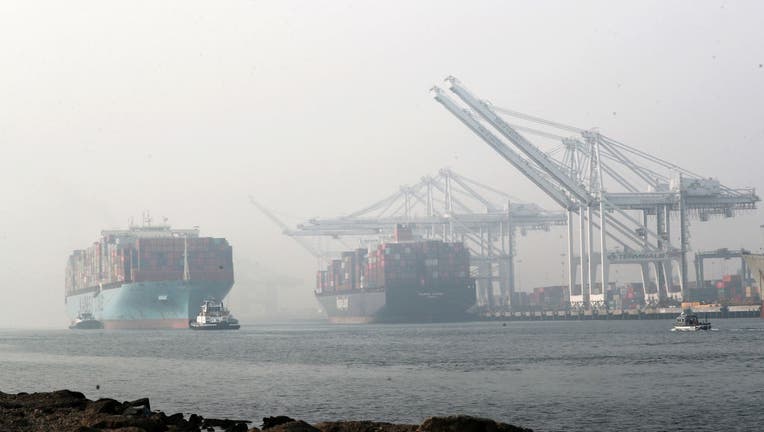Oakland seeks input on how to address pollution in historically redlined communities

OAKLAND, CALIFORNIA - NOVEMBER 16: A cargo ship, left, arrives at the Port of Oakland among the air pollution in Oakland, Calif., on Friday, Nov. 16, 2018. The bad air continues after a week when the fatal Camp Fire started in Paradise, Calif. (Photo
OAKLAND, Calif. - The city of Oakland is seeking public input on its first "Environmental Justice Element," a new city blueprint which seeks to rectify past policies that have contributed higher levels of pollution in Oakland’s predominantly Black and low-income communities.
Residents have long known about these historical imbalances, but the new report, currently in a draft phase, finally codifies the systemic racism that placed predominantly Black communities near railroad tracks, the Port of Oakland and other polluting industrial centers.
The report has found the largest amounts of pollution lay mostly in historically redlined communities – the flatlands of Oakland which were barred from federal housing loans from the 1930s-1960s. The areas with the largest amount of pollution include Downtown Oakland, Jingletown, Brookfield Village, Chinatown, Jack London Square, and the Hoover-Foster area. Neighborhoods along Interstates 880 and 980 have some of the highest levels of diesel pollution in Oakland due to Interstate 580's truck ban.
The report also found that residents in these areas experience a lower life expectancy than residents living in the Oakland Hills.

This map shows the life expectancy rates among Oakland's various census tracts. Darker areas feature lower life expectancy.
"We have a right to breathe, we have the right to have the same clean air as the people in the [Oakland] Hills area," Ms. Margaret Gordon, cofounder of the West Oakland Environmental Indicators Project, told KTVU.
Gordon is a longtime activist with roots in the Black Panthers, the anti-poverty and anti-apartheid movements, and led city staff drafting the new report on a tour of some of West Oakland’s most polluted areas. For nearly 20 years, Gordon and her colleagues have been collecting incidences of pollution ranging from illegal dump sites to poor air quality to a myriad of pollution emanating from West Oakland’s ports, trucking hubs and former manufacturing centers.
SEE ALSO: Port of Oakland again at odds with neighbors
"We have polluting businesses right where people live," Gordon said. "We have a cement company in the middle of a neighborhood less than four blocks from where people live. Next to the cement company, you have Cast Alloy Scrap Sales."
"Across from that, you got a [car] salvage yard, all of these in one neighborhood," she added.
The Environmental Justice Element will lay out a roadmap to improve "the environmental health of those most harmed by pollution burdens and impacted by historic disinvestment and disenfranchisement by investing in these communities to create opportunities that will allow its residents to live long, healthy lives," the element states.
Plans go much beyond just standard environmental concerns. A core part of it will feature incentives to bring grocery stores to some of Oakland’s food deserts, and plans to increase pedestrian access citywide. Once implemented, the Environmental Justice Element will feature a "comprehensive zoning update process" that will allow for denser and taller housing projects, and changes to the commercial and industrial zoning areas to improve air quality, Lakshmi Rajagopalan, a planner with the City of Oakland, told KTVU in an email.
SEE ALSO: West Oakland grocery store's closure leaves void, concerns of food desert
"Historical and ongoing governmental and industrial practices have led to, and continue to generate, racially inequitable outcomes, and longstanding environmental injustices in Oakland," Rajagopalan added. "An environmental justice approach seeks to rectify these issues, improving the environmental health of those most harmed by pollution burdens and impacted by historic disinvestment and disenfranchisement by investing in these communities to create opportunities that will allow its residents to live long, healthy lives."
The public comment period lasts until June 22 and residents can contribute in three ways: By emailing city staff at generalplan@oaklandca.gov, commenting directly on an interactive draft, or by attending community events posted on the city’s website. A final version of the report is expected to be released in September.
Freddy Brewster is a reporter for KTVU.
Email Freddy at freddy.brewster@fox.com or call him at 513-379-7522.
Follow him on Twitter @freddy_brewster

